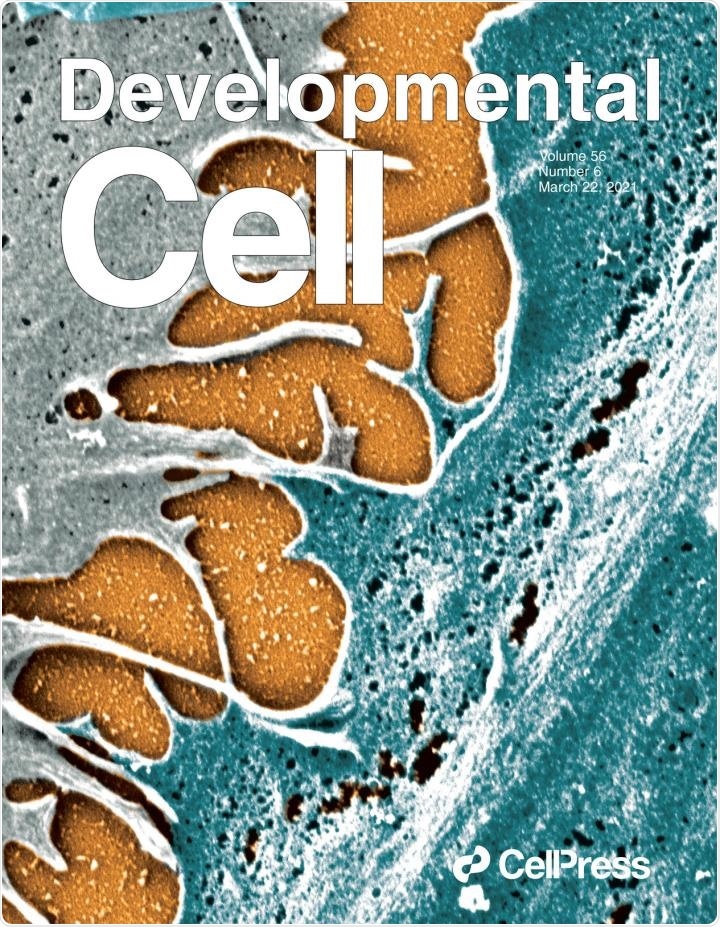The skin is known to be the largest organ in the human body, and its outermost layer, called the epidermis, is renewed every three weeks.

Cover image: Volume 56| Issue 6. Image Credit: Avinanda Banerjee.
The cells, driving this renewal of epidermal stem cells, are located in a specialized niche or areas inside a region of the hair follicle (or root), called the “bulge compartment.” The stem cells residing in the bulge compartment are multipotent, which means they can help repair damaged skin as well as regenerate the hair follicles at the time of normal development.
Although many teams have focused their efforts on stem cells, little is known about the niche or extrinsic factors that affect the state of these stem cells.
Dr. Srikala Raghavan and her research team at the Centre for Inflammation and Tissue Homeostasis (CITH) theme, DBT-inStem have discovered the function of strong cell adhesion between stem cells in preserving their quiescent properties. The new study has been published in the Developmental Cell journal.
The researchers targeted a protein, known as vinculin, a kind of “mechanotransducer” expressed in the skin. Mechanotransducers are essentially proteins that communicate by producing a force inside the cell by interacting with the cytoskeleton of the cell. Vinculin is located at cell junctions, also called the “adherens junction,” and between the substratum and the cell, called“focal adhesion.”
When the vinculin gene was deleted from the epidermal compartment (called a conditional knockout, or cKO), the researchers unexpectedly found that the animals were completely normal except for a thin coat of hair.
Ritusree Biswas, a graduate student in the Raghavan laboratory, targeted her analysis by studying the behavior of stem cells in hair follicles. Her research works demonstrated that the stem cells found in the vinculin cKO were unable to sustain quiescence.
Since the stem cells were continuously dividing, Biswas was able to demonstrate that these stem cells no longer functioned like traditional stem cells, which consequently contributed to the thin hair phenotype. Another author of the article, Avinanda Banerjee, targeted the mechanism underlying the loss of quiescence in these stem cells.
Banerjee analyzed the forces or mechanotransduction produced by vinculin-deficient cells in association with Professor Yan Jie and his post-doc Zhihai Zhao, at the Mechanobiology Institute (MBI) in Singapore.
When Avinanda quantified the forces at cell junctions produced by vinculin KO (knockout) cells, she found that these cells created roughly half the force than a normal vinculin-expressing cell.
This information indicated that the loss of vinculin was weakening the junctions. This was somewhat surprising because the team had previously demonstrated that all the proteins usually found at junctions were present but at higher levels.
The researchers then focused on interpreting the connection between the loss of stem cell quiescence and the weak junctions. They carried out global gene expression profiling on vinculin KO cells to find pathways that may have altered because of the loss of vinculin. The YAP1 pathway was one of the pathways that underwent a major change.
YAP1 is a transcription factor that regulates the expression of genes controlling the cell cycle. The high expression of the YAP1 transcription factor in the KO explained the increased proliferation of cells and the loss of quiescence.
So, what is causing the dysregulation of YAP1 expression? Since YAP1 is a powerful regulator of cell proliferation, it is usually sequestered at the robust cell-cell junctions seen in quiescent stem cells, also called “contact inhibited state.’'
But since the junctions in the vinculin KO cells were weak, YAP1 was not sequestered at these junctions anymore and could translocate into the nucleus to control the proliferation of cells.
The latest study performed by Raghavan laboratory holds implications that go beyond the skin stem cells. As cancer cells metastasize out of their niche, the expression of cell junction proteins decreases while the expression of YAP1 increases consequently. In an ongoing study, Srikala’s laboratory is investigating how the lack of vinculin influences the signals received by the nucleus.
Source:
Journal reference:
Biswas, R., et al. (2021) Mechanical instability of adherens junctions overrides intrinsic quiescence of hair follicle stem cells. Developmental Cell. doi.org/10.1016/j.devcel.2021.02.020.